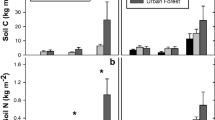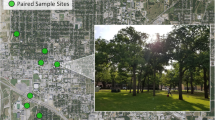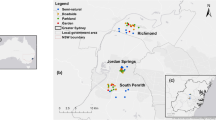Abstract
Concentrated human activities such as the burning of fossil fuels have resulted in chronic nitrogen (N) additions to urban ecosystems. We predicted that urban development in North Texas (NTX; the largest “megapolitan” region in the Great Plains) would be positively correlated with atmospheric concentrations of nitrogen oxides (NOx) and with the leaf tissue quality (lower C:N ratio) and herbivory of the long-lived native tree, post oak (Quercus stellata). Data from air monitoring stations were used to calculate distance-weighted estimates of atmospheric NOx for 11 sites of differing urban development across NTX. Soil samples were collected at each site along with post oak leaves, estimates of herbivory, and measurements of tree size. Percent urban development was strongly positively correlated with atmospheric NOx concentrations, though there was no correlation between atmospheric NOx and soil N. There was a positive relationship between soil N and leaf tissue quality, but only where atmospheric NOx was relatively low, possibly due to factors that covary with urban development. Herbivory was not significantly correlated with leaf tissue quality, but leaves from the two most urban sites had the greatest amount of insect herbivory. The NOx concentrations in NTX were lower than other industrialized cities, which may be due to climate and topography differences or the relatively young age of this urban area. This study adds to the expanding body of literature examining how urban ecosystems are affected (or not) by N deposition and suggests that interactions among NOx, soils, and plants are complex and sometimes, counterintuitive.






Similar content being viewed by others
References
Aber JD, Melillo JM (2001) Terrestrial ecosystems, Second edn. Academic Press, San Diego
Aronson MFJ, Handel SN, Puma IP, Clemants SE (2014) Urbanization promotes non-native woody species and diverse plant assemblages in the New York metropolitan region. Urban Ecosystems 18:31–45. doi:10.1007/s11252-014-0382-z
Bai SH, Xu Z, Blumfield TJ, Reverchon F (2015) Human footprints in urban forests: implication of nitrogen deposition for nitrogen and carbon storage. J Soils Sediments 15:1927–1936. doi:10.1007/s11368-015-1205-4
Bedison JE, McNeil BE (2009) Is the growth of temperate Forest trees enhanced along an Abient nitrogen deposition gradient? Ecology 90:1736–1742
Bobbink R, Roelofs JGM (1995) Ecological effects of atmospheric deposition on non-forest ecosystems in Western Europe. In: Heij GJ, Erisman JW (eds) Studies in Environmental Science, vol 64. Elsevier, pp 279–292. https://www.elsevier.com/books/acid-rain-research-do-we-have-enoughanswers/erisman/978-0-444-82038-9
Bobbink R et al (2010) Global assessment of nitrogen deposition effects on terrestrial plant diversity: a synthesis. Ecol Appl 20:30–59. doi:10.1890/08-1140.1
Boggs JL, McNulty SG, Gavazzi MJ, Myers JM (2005) Tree growth, foliar chemistry, and nitrogen cycling across a nitrogen deposition gradient in southern Appalachian deciduous forests. Can J For Res 35:1901–1913. doi:10.1139/x05-128
Brazel A, Selover N, Vose R, Heisler G (2000) The tale of two climates - Baltimore and phoenix urban LTER sites. Clim Res 15:123–135
Butler TJ, Likens GE, Vermeylen FM, Stunder BJB (2003) The relation between NOx emissions and precipitation NO3− in the eastern USA. Atmos Environ 37:2093–2104. doi:10.1016/s1352-2310(03)00103-1
Butler TJ, Likens GE, Vermeylen FM, Stunder BJB (2005) The impact of changing nitrogen oxide emissions on wet and dry nitrogen deposition in the northeastern USA. Atmos Environ 39:4851–4862. doi:10.1016/j.atmosenv.2005.04.031
Chapin FS III (1980) The mineral nutrition of wild plants. Annu Rev Ecol Syst 11:233–260
Diggs GM, Lipscomb BL, O'Kennon RJ, Mahler WF, Shinners LH (1999) Shinners' and Mahler's illustrated flora of north Central Texas. Botanical Research Institute of Texas, Fort Worth
Du E, de Vries W, Galloway JN, Hu X, Fang J (2014) Changes in wet nitrogen deposition in the United States between 1985 and 2012. Environ Res Lett 9:095004. doi:10.1088/1748-9326/9/9/095004
Elliott EM et al (2007) Nitrogen isotopes as indicators of NOx source contributions to atmospheric nitrate deposition across the Midwestern and northeastern United States. Environ Sci Technol 41:7661–7667. doi:10.1021/es070898t
Fox J et al. (2009) CAR: Companion to applied regression, R Package version 1.2–16. http://cran.r-project.org/web/packages/car/index.html. Accessed August 2012
Galloway JN et al (2008) Transformation of the nitrogen cycle: recent trends, questions, and potential solutions. Science 320:889–892. doi:10.1126/science.1136674
Gao HO (2007) Day of week effects on diurnal ozone/NOx cycles and transportation emissions in Southern California. Transp Res Part D: Transp Environ 12:292–305. doi:10.1016/j.trd.2007.03.004
George K, Ziska LH, Bunce JA, Quebedeaux B (2007) Elevated atmospheric CO2 concentration and temperature across an urban–rural transect. Atmos Environ 41:7654–7665. doi:10.1016/j.atmosenv.2007.08.018
Griffith G, Bryce S, Omernik J, Rogers A (2007) Ecoregions of Texas. Texas Commission on Environmental Quality, Austin
Grimm NB et al (2008) The changing landscape: ecosystem responses to urbanization and pollution across climatic and societal gradients. Front Ecol Environ 6:264–272. doi:10.1890/070147
Hagemann R, Corsmeier U, Kottmeier C, Rinke R, Wieser A, Vogel B (2014) Spatial variability of particle number concentrations and NOx in the Karlsruhe (Germany) area obtained with the mobile laboratory ‘AERO-TRAM’. Atmos Environ 94:341–352. doi:10.1016/j.atmosenv.2014.05.051
Homer CG et al (2015) Completion of the 2011 National Land Cover Database for the conterminous United States - representing a decade of land cover change information. Photogramm Eng Remote Sens 81:345–354
Kahan A, Currie W, Brown D (2014) Nitrogen and carbon biogeochemistry in Forest sites along an indirect urban–rural gradient in southeastern Michigan. Forests 5:643–665
Lawrence GB, Goolsby DA, Battaglin WA, Stensland GJ (2000) Atmospheric nitrogen in the Mississippi River basin — emissions, deposition and transport. Sci Total Environ 248:87–100. doi:10.1016/S0048-9697(99)00533-1
Lebauer DS, Treseder KK (2008) Nitrogen limitation of net primary productivity in terrestrial ecosystems is globally distributed. Ecology 89:371–379
Li Y, Schichtel BA, Walker JT, Schwede DB, Chen X, Lehmann CMB, Puchalski MA, Gay DA, Collett JL (2016) Increasing importance of deposition of reduced nitrogen in the United States. Proc Natl Acad Sci 113(21):5874–5879. doi:10.1073/pnas.1525736113
Likens GE, Buso DC, Butler TJ (2005) Long-term relationships between SO2 and NOx emissions and SO42- and NO3- concentration in bulk deposition at the Hubbard brook experimental Forest, NH. J Environ Monit 7:964–968. doi:10.1039/B506370A
Lu Z, Streets DG, de Foy B, Lamsal LN, Duncan BN, Xing J (2015) Emissions of nitrogen oxides from US urban areas: estimation from ozone monitoring instrument retrievals for 2005–2014. Atmos Chem Phys Discuss 15:14961–15003. doi:10.5194/acpd-15-14961-2015
McNeil BE, Read JM, Driscoll CT (2007) Foliar nitrogen responses to elevated atmospheric nitrogen deposition in nine temperate Forest canopy species. Environ Sci Technol 41:5191–5197. doi:10.1021/es062901z
Melillo JM, Richmond TT, Yohe G (2014) Climate Change Impacts in the United States: The Third National Climate Assessment. doi:10.7930/J0Z31WJ2
National Oceanic and Atmospheric Administration (2016) U.S. Climate Divisions. http://www.ncdc.noaa.gov/monitoring-references/maps/us-climate-divisions.php. Accessed August 2015
Pan J, Widner B, Ammerman D, Drenovsky R (2010) Plant community and tissue chemistry responses to fertilizer and litter nutrient manipulations in a temperate grassland. Plant Ecol 206:139–150. doi:10.1007/s11258-009-9630-3
Phoenix GK et al (2012) Impacts of atmospheric nitrogen deposition: responses of multiple plant and soil parameters across contrasting ecosystems in long-term field experiments. Glob Chang Biol 18:1197–1215. doi:10.1111/j.1365-2486.2011.02590.x
Pickett STA et al (2011) Urban ecological systems: scientific foundations and a decade of progress. J Environ Manag 92:331–362. doi:10.1016/j.jenvman.2010.08.022
R Core Team (2014) R: A language and environment for statistical computing. R Foundation for Statistical Computing. http://www.R-project.org/
Rao P, Hutyra L, Raciti S, Templer P (2013) Atmospheric nitrogen inputs and losses along an urbanization gradient from Boston to Harvard Forest, MA. Biogeochemistry:1–17. doi:10.1007/s10533-013-9861-1
Raupp MJ, Shrewsbury PM, Herms DA (2010) Ecology of herbivorous arthropods in urban landscapes. Annu Rev Entomol 55:19–38. doi:10.1146/annurev-ento-112408-085351
Redling K, Elliott E, Bain D, Sherwell J (2013) Highway contributions to reactive nitrogen deposition: tracing the fate of vehicular NOx using stable isotopes and plant biomonitors. Biogeochemistry 116:261–274. doi:10.1007/s10533-013-9857-x
Revelle W (2014) psych: Procedures for personality and psychological research. https://cran.r-project.org/web/packages/psych/index.html. Accessed April 2016
Searle SY, Turnbull MH, Boelman NT, Schuster WSF, Yakir D, Griffin KL (2012) Urban environment of New York City promotes growth in northern red oak seedlings. Tree Physiol 32:389–400. doi:10.1093/treephys/tps027
Seto KC, Guneralp B, Hutyra LR (2012) Global forecasts of urban expansion to 2030 and direct impacts on biodiversity and carbon pools. Proc Natl Acad Sci U S A 109:16083–16088. doi:10.1073/pnas.1211658109
Shen W, Wu J, Grimm N, Hope D (2008) Effects of urbanization-induced environmental changes on ecosystem functioning in the phoenix metropolitan region, USA. Ecosystems 11:138–155. doi:10.1007/s10021-007-9085-0
Song F, Young Shin J, Jusino-Atresino R, Gao Y (2011) Relationships among the springtime ground–level NOx, O3 and NO3 in the vicinity of highways in the US East Coast. Atmos Pollut Res 2:374–383. doi:10.5094/APR.2011.042
TCEQ (2015a) Air Monitoring Sites. http://www17.tceq.texas.gov/tamis/index.cfm?fuseaction=home.welcome. Accessed April 2014
TCEQ (2015b) Texas Five-Year Ambient Monitoring Network Assessment
Texas A&M Forest Service (2015) Forest Health: Insects. http://texasforestservice.tamu.edu/foresthealth/insects/. Accessed February 2016
Texas Water Deveopment Board (2012) Water for Texas 2012 State Water Plan. Texas
U.S. Census Bureau (2016) Annual Estimates of the Resident Population: April 1, 2010 to July 1, 2015
Vellingiri K, Kim K-H, Jeon JY, Brown RJC, Jung M-C (2015a) Changes in NOx and O3 concentrations over a decade at a central urban area of Seoul, Korea. Atmos Environ 112:116–125. doi:10.1016/j.atmosenv.2015.04.032
Venables W, Ripley B (2002) Modern applied statistics using S. Springer, New York
Vision North Texas (2008) Regional Choices Report. http://www.visionnorthtexas.org/regionalchoices/regionalchoices.html. Accessed April 2016
Vitousek PM et al (1997) Human alteration of the global nitrogen cycle- sources and consequences. Ecol Appl 7:737–750
Xia J, Wan S (2008) Global response patterns of terrestrial plant species to nitrogen addition. New Phytol 179:428–439. doi:10.1111/j.1469-8137.2008.02488.x
Xie M et al (2016) Temporal characterization and regional contribution to O3 and NOx at an urban and a suburban site in Nanjing, China. Sci Total Environ 551–552:533–545. doi:10.1016/j.scitotenv.2016.02.047
Yang H, Li Y, Wu M, Zhang ZHE, Li L, Wan S (2011a) Plant community responses to nitrogen addition and increased precipitation: the importance of water availability and species traits. Glob Chang Biol 17:2936–2944. doi:10.1111/j.1365-2486.2011.02423.x
Yang Y, Luo Y, Lu M, Schädel C, Han W (2011b) Terrestrial C:N stoichiometry in response to elevated CO2 and N addition: a synthesis of two meta-analyses. Plant Soil 343:393–400. doi:10.1007/s11104-011-0736-8
Zhang R, Tie X, Bond DW (2003) Impacts of anthropogenic and natural NOx sources over the US on tropospheric chemistry. Proc Natl Acad Sci 100:1505–1509
Acknowledgements
This research was supported by a grant from the Beta Phi Chapter of the Phi Sigma Biological Honors Society at UTA. Thank you to Dr. Thomas Chrzanowski of UTA, Dr. Melanie Sattler of UTA, Gautam Raghavendra of UTA and Jayme Walton of SWCA Environmental Consultants.
Author information
Authors and Affiliations
Corresponding author
Rights and permissions
About this article
Cite this article
Green, M.L., Foster, K. & Gough, L. Urban development in the southern Great Plains: effects of atmospheric NOx on the long-lived post oak tree (Quercus stellata). Urban Ecosyst 20, 651–661 (2017). https://doi.org/10.1007/s11252-016-0622-5
Published:
Issue Date:
DOI: https://doi.org/10.1007/s11252-016-0622-5




